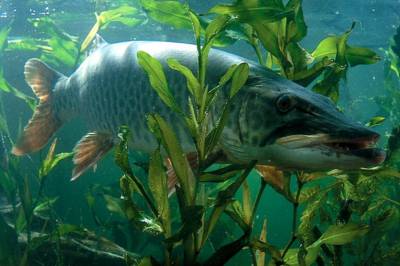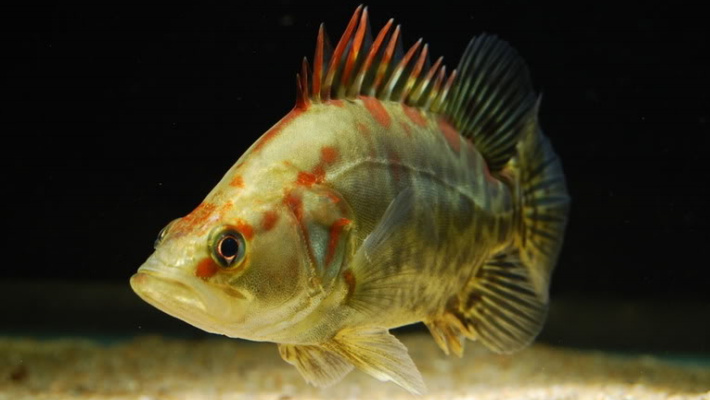Microsmatic fish are represented by species in which the well developed
visual system provides most of the behavioural responses in comparison with the
less developed chemosensory system (Devitsina & Malyukina, 1977). Visually
guided diurnal or twilight predators, like Northern pike, Esox lucius, and other Esocidae, on the one hand, and visually
guided planktoneaters, like Black Sea black-striped pipefish,
Syngnathus nigrolineatus, and
other Syngnathidae, on the second hand, form this group of fish (e.g.,
Doroshenko, 2008). In general, the chemosensory system of microsmatic fish
provides first of all their reproductive behaviour, spatial migration,
partially anti-predator behaviour and is weak or indifferent in providing
feeding responses.
Data for microsmatic fish are given by many authors (Hara, 1975; Devitsina, 1977; Devitsina & Malyukina, 1977; Doroshenko, 1981, 2008).
Pike & Musky
According to data received by Devitsyna & Malyukina (1977) in the electrophysiological experiments, the olfactory system of pike, E. lucius, responds
only to conspecific sexual pheromones (gonad extracts), but does not respond to conspecific odors, pure water and feeding substances like fish blood or tissue extracts. In the behavioural
experiments with pike, Nilsson & Brönmark (1999) have found that the
chemical cues from the foraging conspecifics render only minor effects upon
the foraging individuals. In the behavioural
experiments with pike, Nilsson & Brönmark (1999) have found that the
chemical cues from the foraging conspecifics render only minor effects upon
the foraging individuals.
In feeding behaviour, musky, E. masquinongy, use mainly vision and lateral sensory systems (New et al., 2001).
Pike larvae decrease the frequency of their attacks
on zooplankters and show other anti-predator responses to chemical cues of Eurasian
perch, Perca fluviatilis (Lehtiniemi,
2005; Lehtiniemi et al., 2005). Chemical cues of perch (water
from under adult predators, 15
cm length, fed on pike larvae until experiments) affect alone,
but chemical and visual cues offered together are more effective. Furthermore, it is shown that pike are attracted by alarm
pheromone of fathead minnow, Pimephales
promelas (Mathis et al., 1995; Chivers et al., 1996; indirect data by Wisenden
& Thiel, 2001). In addition, pike demonstrate distinct foraging responses
to artificial hypoxanthin-3(N)-oxide (Mathis et al., 1995) identified as an
active component of ostariophysan fish alarm pheromones.
The skin of esociformes represented by the foregoing pike,
as well as blackfish and mudminnow, does not contain special cells with alarm pheromones (Pfeiffer,
1960; Wisenden et al., 2007) like special cells in the skin of ostariophysans and perciformes. In conformity with these data, pike, E. lucius, (recall that pike are large
predatory fish) do not exhibit any alarm responses on conspecific skin extracts
(Schutz, 1956). Activities of these extracts are registered at the
central neural level of
pike's olfactory system (Devitsyna & Malyukina, 1977), but this discrepancy with
the foregoing data can be explained by the methodological features. Another esociform
fish, central mudminnow,
Umbra limi, (mudminnow are small
chiefly benthivorous fish) exhibit distinct alarm responses to conspecific skin
extracts (Wisenden et. al., 2007). In contrast to solitary pike, selection of mudminnow
on respond to public chemical information (for review, see Wisenden & Chivers,
2006; Wisenden et al., 2007) may be determined by gregariousness of these fish,
their small size and thus their vulnerability to predators.
Basic References
Chivers
D.P., Brown G.E., Smith R.J.F. 1996. The
evolution of chemical alarm signals: attracting predators benefits alarm
signal senders. The American Naturalist 148, 649-659
Devitsyna G.V. 1977. Comparative study of the
olfactory analyser morphology in fishes. Journal of Ichthyology 17,
129-139
Devitsyna G.V., Malyukina G.A. 1977. On the functional organization of the olfactory organ
in macro- and microsmatic fishes. Journal of Ichthyology 17, 493-502
Doroshenko M.A. 1981. Comparative
morphometric analysis of the olfactory
system in marine fishes. Russian Journal
of Marine Biology 3, 3–14
Doroshenko M.A. 2008. Sensory
differentiation of marine fishes on the olfactory groups in connection with
their ecological specialization. World Ocean
Researches: Proceedings of the International
Scientific Conference,
Far East State
Technical Fishery
University, Vladivostok, 32-35
Hara T.J. 1975. Olfaction in fish. Progress in Neurobiology 5, 271-335
Lehtiniemi M. 2005. Swim or
hide: predator cues cause species specific reactions in young fish larvae. Journal of Fish Biology 66, 1285–1299
Lehtiniemi M., Engström-Öst J., Viitasalo M. 2005. Turbidity decreases anti-predator
behaviour in pike larvae (Esox lucius). Environmental Biology of Fishes 37, 1-8
Liang
X.F., Liu J.K., Huang B.Y. 1998. The role of
sense organs in the feeding behaviour of Chinese perch. Journal of Fish
Biology 52, 1058-1067
Mathis
A., Chivers D.P., Smith R.J.F. 1995. Chemical
alarm signals: predator detterents or predator attractants? The American
Naturalist 145, 994-1005
New
J.G., Fewkes L.A., Khan A.N. 2001. Strike
feeding behavior in the muskellunge, Esox masquinongy: contributions of the
lateral line and visual sensory systems. Journal of Experimental Biology 204, 1207-1221
Nilsson P.A., Brönmark C . 1999.
Foraging among cannibals and kleptoparasites: effects of prey size on pike behavior. Behavioral
Ecology 10, 557-566
Pfeiffer
W. 1960. Über die
Schreckreaktion bei Fischen und die Herkunft des Schreckstoffes. Zeitschrift für vergleichende Physiologie 43, 578–614
Schutz F. 1956. Vergleichende Untersuchungen über die Schreckreaktion bei Fischen und deren Verbreitung. Zeitschrift für vergleichende Physiologie 38, 84–135
Wisenden
B.D., Thiel T.A. 2001. Field verification of
predator attraction to minnow alarm substance. Journal of Chemical
Ecology 28, 417-422
Wisenden B.D., Chivers D.P. 2006.
The role of public chemical information in antipredator behaviour. In: Communication
in fishes. Edited by Ladich F., Collins S.P., Moller P., Kapoor
B.G. New Hampshire,
p. 259-278
Wisenden
B.D., Karst J.,
Miller J., Miller S., Fuselier L. 2007. Anti-predator behaviour in response to
conspecific chemical alarm cues in an esociform fish, Umbra limi (Kirtland 1840). Environmental Biology of Fishes 82, 85-92
|








 SUBSCRIBE
SUBSCRIBE



